Aspects of Homogeneous Heterogeneous Reactions for Nanofluid Flow Over a Riga Surface in the Presence of Viscous Dissipation
Abstract
:1. Introduction
2. Formulation
3. Solution Methodology
4. Discussion
5. Closing Remarks
- The obtained results for SWCNT and MWCNT signify that flow acceleration depends on larger values of the modified Hartmann number and the nanoparticles volume fraction parameter ;
- We observed a considerable degree of resistance during flow when the values of the porous medium parameter are increased. We noticed the decreasing effect of the dimensionless parameter on the velocity profile in both types of carbon nanotubes;
- Single-walled carbon nanotubes possess a higher temperature distribution in comparison with multi-wall carbon nanotubes in cases of nanoparticles volume fraction , modified Hartmann number , dimensionless parameter , and thermal radiation parameter . This discovery can assist engineers in the thermal management of different devices;
- The concentration distribution experiences a reducing effect when the strength of the homogeneous parameter increases;
- With the ascent of heterogeneous parameter strength and Schmidt number , the concentration profiles increase for SWCNT and MWCNT. The increase in is related to the increase in the fluid’s kinematic viscosity;
- The skin friction coefficient increase causes additional sheer stress for all the elevated values of the significant parameters, while in case of the Nusselt number, an enhancing behavior is presented only for and , which are ultimately responsible for increased flow convection rates.
Author Contributions
Funding
Institutional Review Board Statement
Informed Consent Statement
Data Availability Statement
Conflicts of Interest
References
- Iijima, S. Helical microtubules of graphitic carbon. Nature 1991, 354, 56–58. [Google Scholar] [CrossRef]
- Younes, H.; Christensen, G.; Li, D.; Hong, H.; Ghaferi, G.G. Thermal conductivity of nanofluids. J. Nanofluids. 2015, 4, 107–132. [Google Scholar] [CrossRef]
- Valipour, P.; Moradi, R.; Aski, F.S. CNT-water nanofluid thermal radiation heat transfer over a stretching sheet considering heat generation. J. Mol. Liq. 2017, 237, 242–246. [Google Scholar] [CrossRef]
- Sadiq, M.A.; Haider, F.; Hayat, T.; Alsaedi, A. Partial slip in Darcy-Forchheimer carbon nanotubes flow by rotating disk. Int. Commun. Heat Mass Transf. 2020, 116, 104641. [Google Scholar] [CrossRef]
- Anuar, N.S.; Bachok, N.; Arifin, N.; Rosali, H. Role of multiple solutions in flow of nanofluids with carbon nanotubes over a vertical permeable moving plate. Alex. Eng. J. 2020, 59, 763–773. [Google Scholar] [CrossRef]
- Ahmad, F.; Abdal, S.; Ayed, H.; Hussain, S.; Salim, S.; Almatroud, A.O. The improved thermal efficiency of Maxwell hybrid nanofluid comprising of graphene oxide plus silver / kerosene oil over stretching sheet. Case Stud. Therm. Eng. 2021, 27, 101257. [Google Scholar] [CrossRef]
- Li, D.; Mahmoud, M.Z.; Suksatan, W.; Kuznetsova, M.; Abed, A.M.; Hekmatifar, M.; Toghraie, D.; Sabetvand, R. Thermal behavior of water base-fluid in the presence of graphene nanosheets and carbon nanotubes: A molecular dynamics simulation. Case Stud. Therm. Eng. 2021, 28, 101669. [Google Scholar] [CrossRef]
- Noranuar, W.N.N.; Mohamad, A.Q.; Shafie, S.; Khan, I.; Jiann, L.Y.; Ilias, M.R. Non-coaxial rotation flow of MHD Casson nanofluid carbon nanotubes past a moving disk with porosity effect. Ain Shams Eng. J. 2021, 12, 4099–4110. [Google Scholar] [CrossRef]
- Reddy, M.G.; Kumar, K.G. Cattaneo-Christov heat flux feature on carbon nanotubes filled with micropolar liquid over a melting surface: A stream line study. Int. Commun. Heat Mass Transf. 2021, 122, 105142. [Google Scholar] [CrossRef]
- Mahmoudpour, E.; Esmaeili, M. Nonlinear free and forced vibration of carbon nanotubes conveying magnetic nanoflow and subjected to a longitudinal magnetic field using stress-driven nonlocal integral model. Thin-Walled Struct. 2021, 166, 108134. [Google Scholar] [CrossRef]
- Ganesh, N.V.; Al-Mdallal, Q.M.; Öztop, H.F.; Kalaivanan, R. Analysis of natural convection for a Casson-based multiwall carbon nanotube nanofluid in a partially heated wavy enclosure with a circular obstacle in the presence of thermal radiation. J. Adv. Res. 2022, 39, 167–185. [Google Scholar] [CrossRef] [PubMed]
- Alzahrani, F.; Khan, M.I. Analysis of Wu’s slip and CNTs (single and multi-wall carbon nanotubes) in Darcy-Forchheimer mixed convective nanofluid flow with magnetic dipole: Intelligent nano-coating simulation. Mater. Sci. Eng. B 2022, 277, 115586. [Google Scholar] [CrossRef]
- Yinusa, A.; Sobamowo, M.; Adelaja, A. Thermal analysis of nanofluidic flow through multi-walled carbon nanotubes subjected to perfectly and imperfectly bonded wall conditions. Chem. Thermodyn. Therm. Anal. 2022, 5, 100028. [Google Scholar] [CrossRef]
- Zubair, G.; Shoaib, M.; Khan, M.I.; Naz, I.; Althobaiti, A.; Raja, M.A.Z.; Jameel, M.; Galal, A.M. Intelligent supervised learning for viscous fluid submerged in water based carbon nanotubes with irreversibility concept. Int. Commun. Heat Mass Transf. 2022, 130, 105790. [Google Scholar] [CrossRef]
- Younes, H.; Mao, M.; Murshed, S.S.; Lou, D.; Hong, H.; Peterson, G. Nanofluids: Key parameters to enhance thermal conductivity and its applications. Appl. Therm. Eng. 2022, 207, 118202. [Google Scholar] [CrossRef]
- Azam, M.; Abbas, N.; Kumar, K.G.; Wali, S. Transient bioconvection and activation energy impacts on Casson nanofluid with gyrotactic microorganisms and nonlinear radiation. Waves Random Complex Media 2022, 1–20. [Google Scholar] [CrossRef]
- Azam, M.; Mabood, F.; Khan, M. Bioconvection and activation energy dynamisms on radiative sutterby melting nanomaterial with gyrotactic microorganism. Case Stud. Therm. Eng. 2021, 30, 101749. [Google Scholar] [CrossRef]
- Azam, M. Bioconvection and nonlinear thermal extrusion in development of chemically reactive sutterby nano-material due to gyrotactic microorganisms. Int. Commun. Heat Mass Transf. 2022, 130, 105820. [Google Scholar] [CrossRef]
- Azam, M. Effects of Cattaneo-Christov heat flux and nonlinear thermal radiation on MHD Maxwell nanofluid with Arrhenius activation energy. Case Stud. Therm. Eng. 2022, 34, 102048. [Google Scholar] [CrossRef]
- Sahu, S.K.; Shaw, S.; Thatoi, D.N.; Azam, M.; Nayak, M.K. Darcy-Forchheimer flow behavior and thermal inferences with SWCNT/MWCNT suspensions due to shrinking rotating disk*. Waves Random Complex Media 2022, 1–29. [Google Scholar] [CrossRef]
- Gailitis, A.; Lielausis, O. On a possibility to reduce the hydrodynamic resistance of a plate in an electrolyte. Appl. Magnetohydrodyn Rep. Phys. Inst. 1961, 12, 143–146. [Google Scholar]
- Pantokratoras, A.; Magyari, E. EMHD free-convection boundary-layer flow from a Riga-plate. J. Eng. Math. 2009, 64, 303–315. [Google Scholar] [CrossRef]
- Pantokratoras, A. The Blasius and Sakiadis flow along a riga-plate. Prog. Comput. Fluid Dyn. An Int. J. 2011, 11, 329–333. [Google Scholar] [CrossRef]
- Mallawi, F.; Bhuvaneswari, M.; Sivasankaran, S.; Eswaramoorthi, S. Impact of double-stratification on convective flow of a non-Newtonian liquid in a Riga plate with Cattaneo-Christov double-flux and thermal radiation. Ain Shams Eng. J. 2021, 12, 969–981. [Google Scholar] [CrossRef]
- Nayak, M.K.; Mehmood, R.; Muhammad, T.; Khan, A.U.; Waqas, H. Entropy minimization in mixed convective Falkner-Skan flow of ZnO-SAE50 nanolubricant over stationary/moving Riga plate. Case Stud. Therm. Eng. 2021, 26, 101176. [Google Scholar] [CrossRef]
- Abdal, S.; Siddique, I.; Alshomrani, A.S.; Jarad, F.; Din, I.S.U.; Afzal, S. Significance of chemical reaction with activation energy for Riga wedge flow of tangent hyperbolic nanofluid in existence of heat source. Case Stud. Therm. Eng. 2021, 28, 101542. [Google Scholar] [CrossRef]
- Li, Y.-X.; Shah, F.; Khan, M.I.; Chinram, R.; Elmasry, Y.; Sun, T.-C. Dynamics of Cattaneo-Christov Double Diffusion (CCDD) and arrhenius activation law on mixed convective flow towards a stretched Riga device. Chaos, Solitons Fractals 2021, 148, 111010. [Google Scholar] [CrossRef]
- Shah, F.; Hayat, T.; Alsaedi, A. Entropy optimization in a fourth grade nanofluid flow over a stretchable Riga wall with thermal radiation and viscous dissipation. Int. Commun. Heat Mass Transf. 2021, 127, 105398. [Google Scholar] [CrossRef]
- Khan, S.A.; Hayat, T.; Alsaedi, A. Melting heat in entropy optimized flow of third grade nanomaterials with radiation by a Riga plate. J. Energy Storage 2022, 45, 103713. [Google Scholar] [CrossRef]
- Asogwa, K.K.; Alsulami, M.D.; Prasannakumara, B.C.; Muhammad, T. Double diffusive convection and cross diffusion effects on Casson fluid over a Lorentz force driven Riga plate in a porous medium with heat sink: An analytical approach. Int. Commun. Heat Mass Transf. 2022, 131, 105761. [Google Scholar] [CrossRef]
- Madhukesh, J.; Ramesh, G.; Aly, E.H.; Chamkha, A.J. Dynamics of water conveying SWCNT nanoparticles and swimming microorganisms over a Riga plate subject to heat source/sink. Alex. Eng. J. 2022, 61, 2418–2429. [Google Scholar] [CrossRef]
- Chaudhary, M.A.; Merkin, J.H. A simple isothermal model for homogeneous heterogenous reactions in boundary-layer flow I. Equal diffusivities. Fluid Dyn. Res. 1995, 16, 311–333. [Google Scholar] [CrossRef]
- Chaudhary, M.A.; Merkin, J.H. A simple isothermal model for homogeneous heterogenous reactions in boundary-layer flow II. Unequal diffusivities. Fluid Dyn. Res. 1995, 16, 335–359. [Google Scholar] [CrossRef]
- Merkin, J. A model for isothermal homogeneous-heterogeneous reactions in boundary-layer flow. Math. Comput. Model. 1996, 24, 125–136. [Google Scholar] [CrossRef]
- Hayat, T.; Masood, F.; Qayyum, S.; Alsaedi, A. Sutterby fluid flow subject to homogeneous–heterogeneous reactions and nonlinear radiation. Phys. A Stat. Mech. Appl. 2020, 544, 123439. [Google Scholar] [CrossRef]
- Waqas, H.; Khan, S.U.; Khan, M.I.; Alzahrani, F.; Qayyum, S. Study of homogeneous--heterogeneous reactions in bioconvection stagnation pointslip flow of Walter’s-B nanofluid with nonlinear thermal radiation and activation energy. Int. Commun. Heat Mass Transf. 2021, 129, 105729. [Google Scholar] [CrossRef]
- Li, Y.-X.; Qayyum, S.; Khan, M.I.; Elmasry, Y.; Chu, Y.-M. Motion of hybrid nanofluid (MnZnFe2O4−NiZnFe2O4−H2O) with homogeneous-heterogeneous reaction: Marangoni convection. Math. Comput. Simul. 2021, 190, 1379–1391. [Google Scholar] [CrossRef]
- Eid, M.R.; Mahny, K.; Al-Hossainy, A.F. Homogeneous-heterogeneous catalysis on electromagnetic radiative Prandtl fluid flow: Darcy-Forchheimer substance scheme. Surf. Interfaces 2021, 24, 101119. [Google Scholar] [CrossRef]
- Pattnaik, P.; Mishra, S.; Bég, O.A.; Khan, U.F.; Umavathi, J. Axisymmetric radiative titanium dioxide magnetic nanofluid flow on a stretching cylinder with homogeneous/heterogeneous reactions in Darcy-Forchheimer porous media: Intelligent nanocoating simulation. Mater. Sci. Eng. B 2022, 277, 115589. [Google Scholar] [CrossRef]
- Ayub, A.; Sabir, Z.; Shah, S.Z.H.; Wahab, H.A.; Sadat, R.; Ali, M.R. Effects of homogeneous-heterogeneous and Lorentz forces on 3-D radiative magnetized cross nanofluid using two rotating disks. Int. Commun. Heat Mass Transf. 2022, 130, 105778. [Google Scholar] [CrossRef]
- Hussain, Z.; Hayat, T.; Alsaedi, A.; Ahmed, B. Darcy Forhheimer aspects for CNTs nanofluid past a stretching cylinder; using Keller box method. Results Phys. 2018, 11, 801–816. [Google Scholar] [CrossRef]
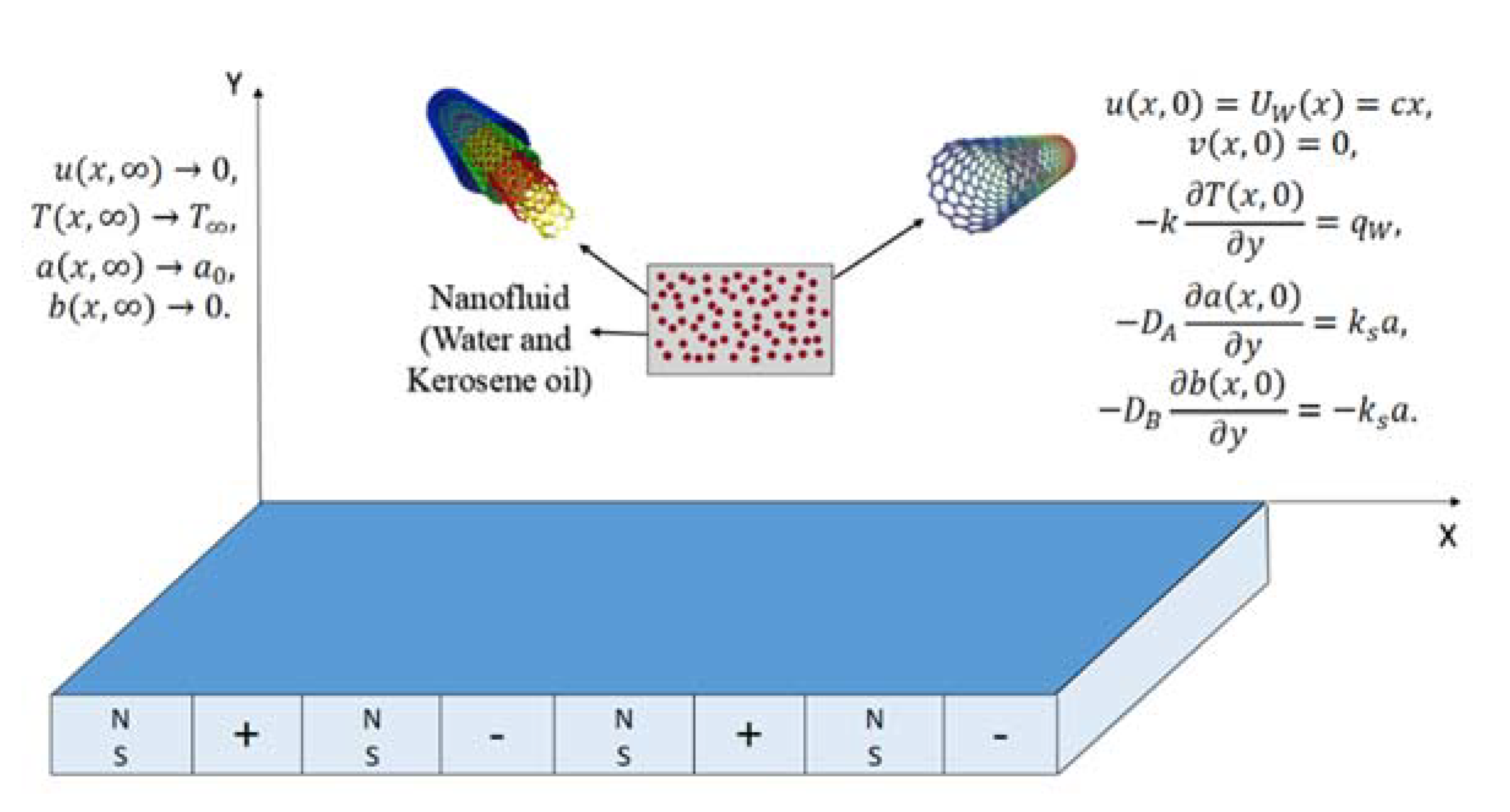




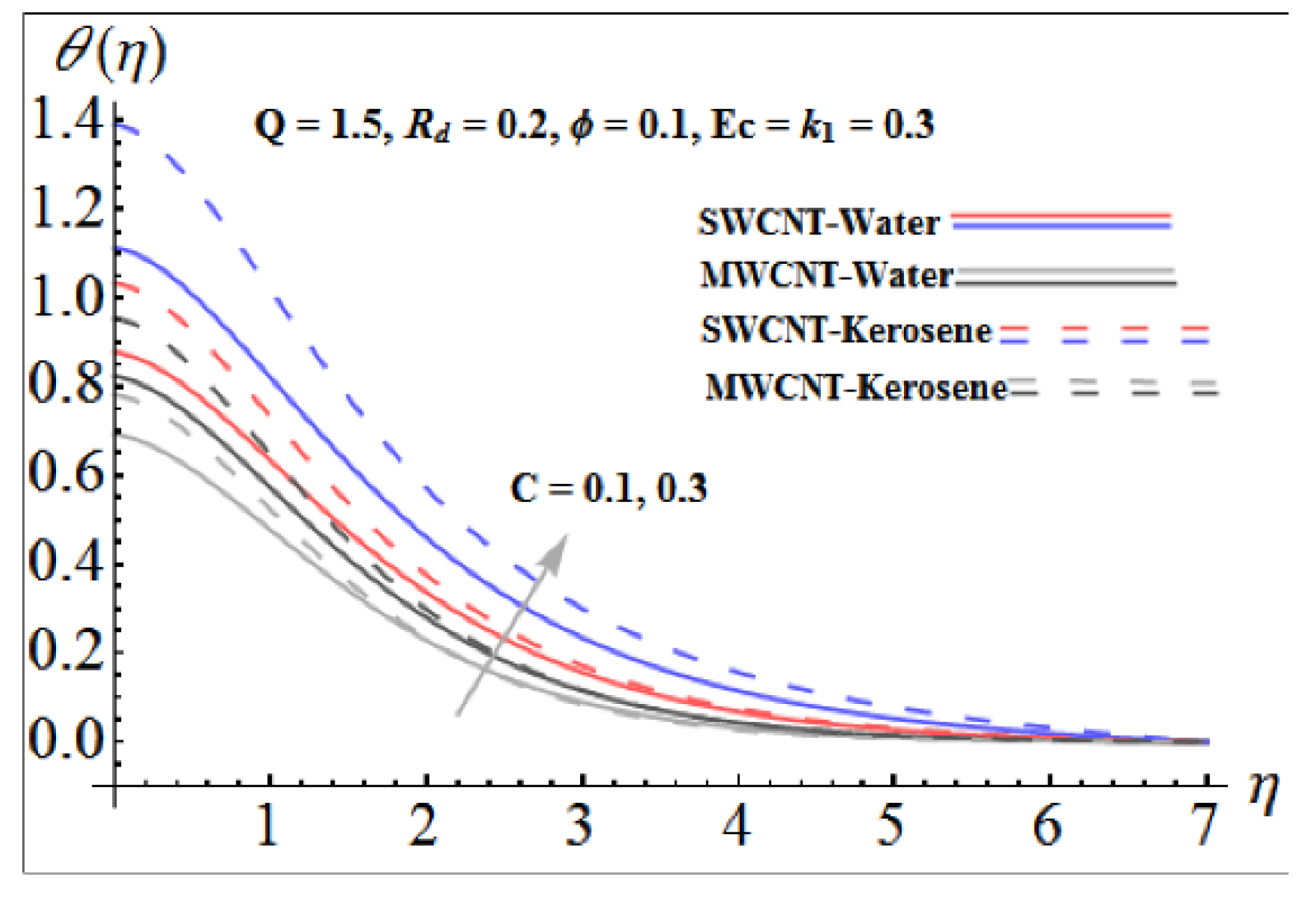
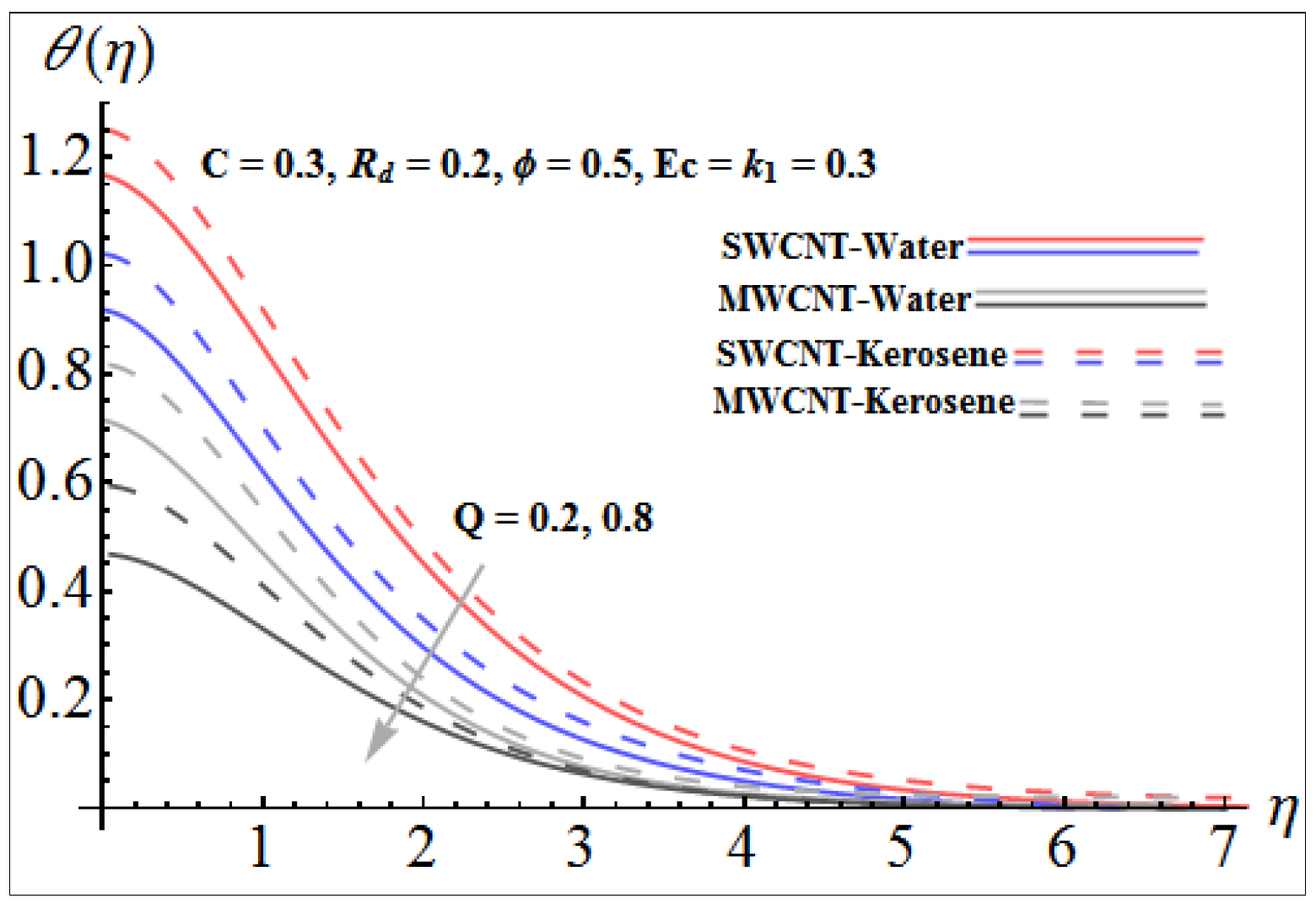
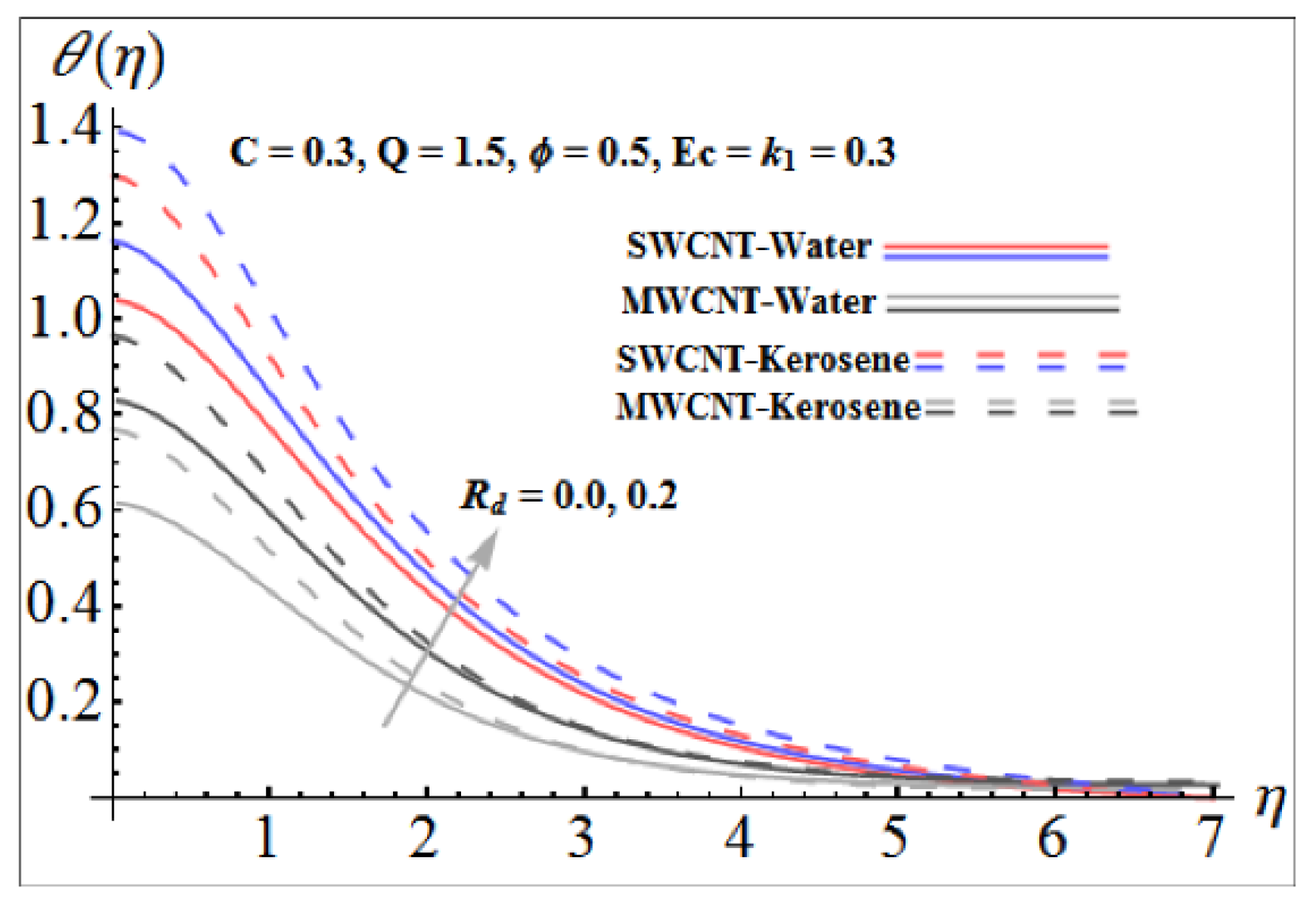
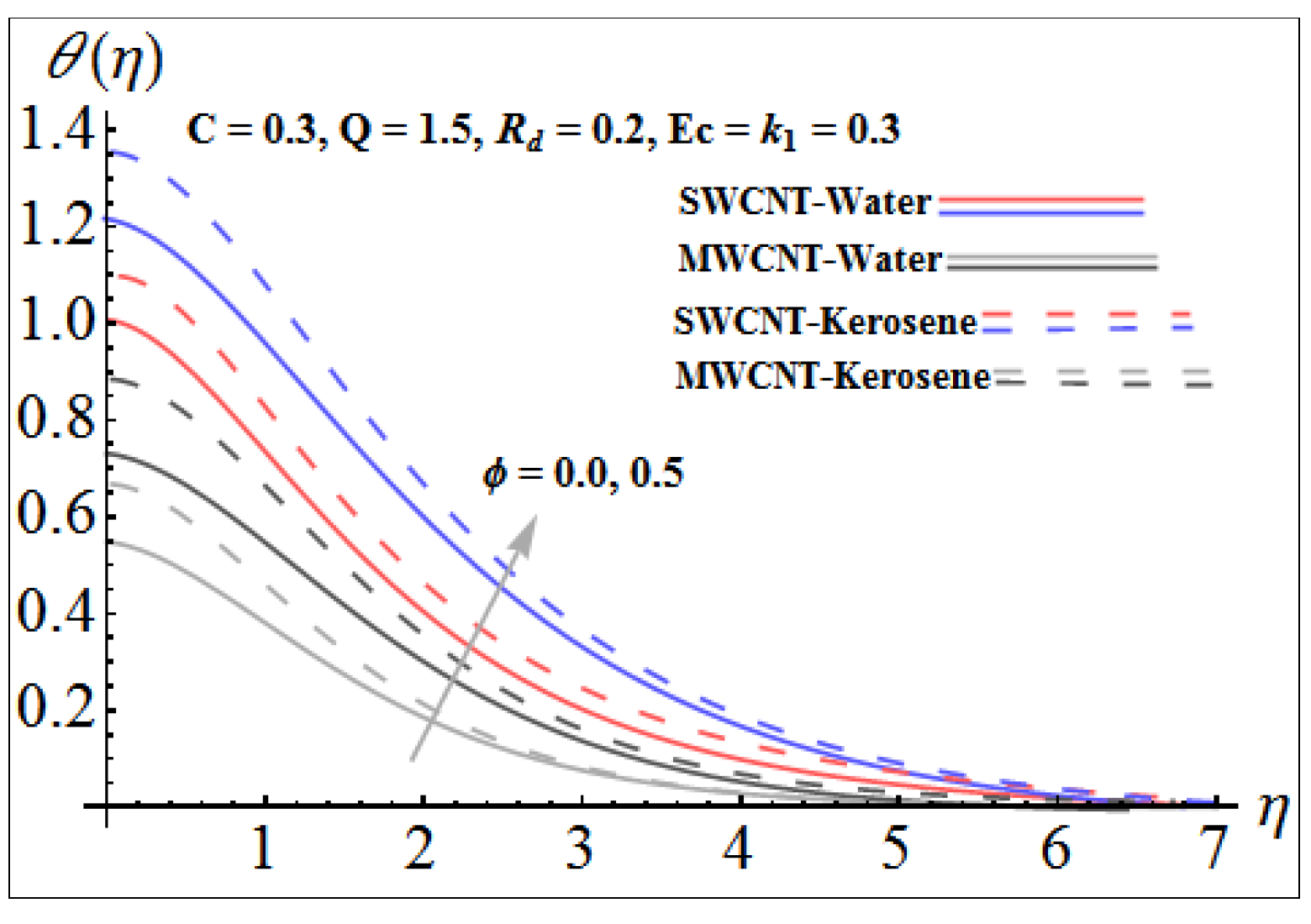
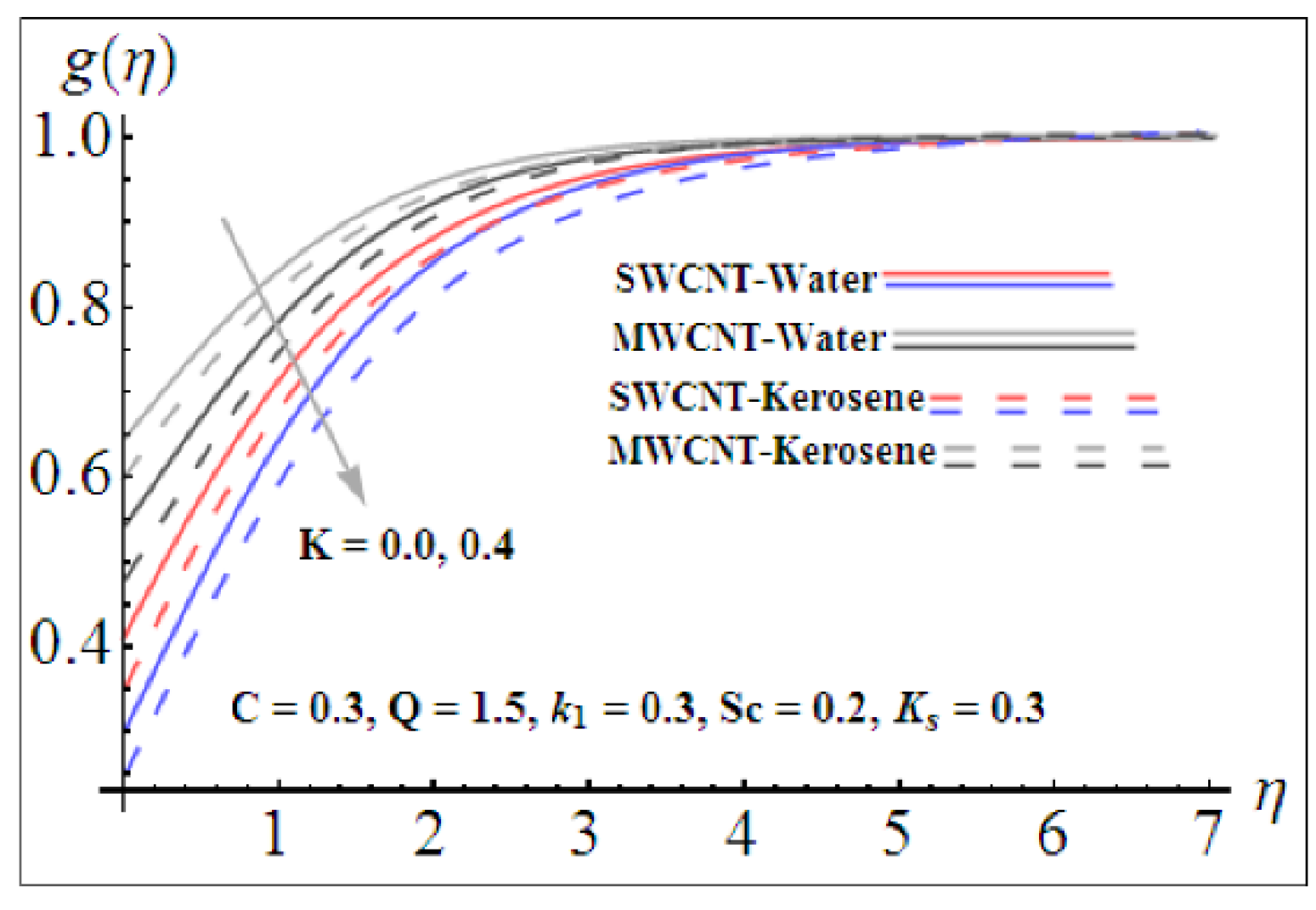
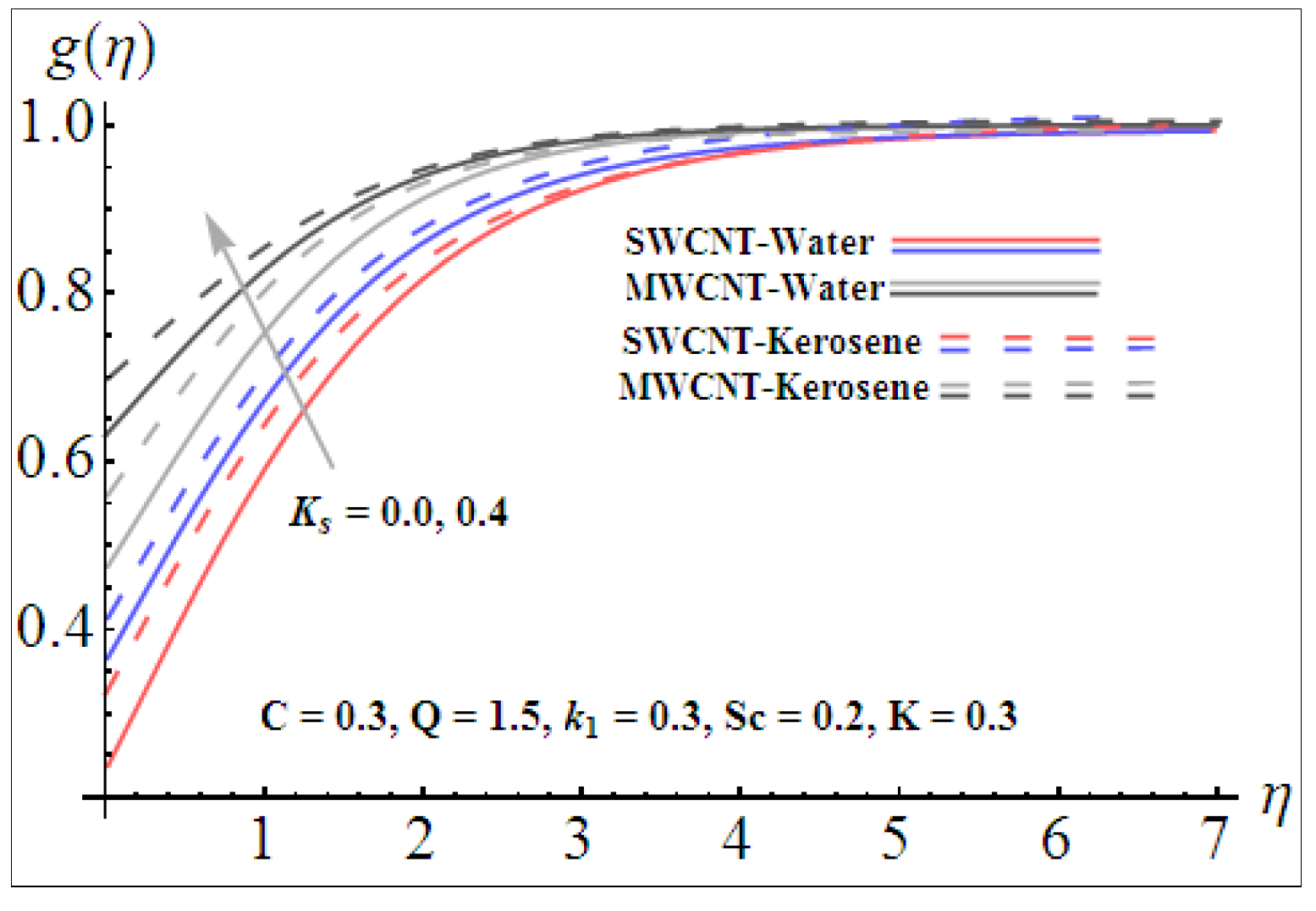
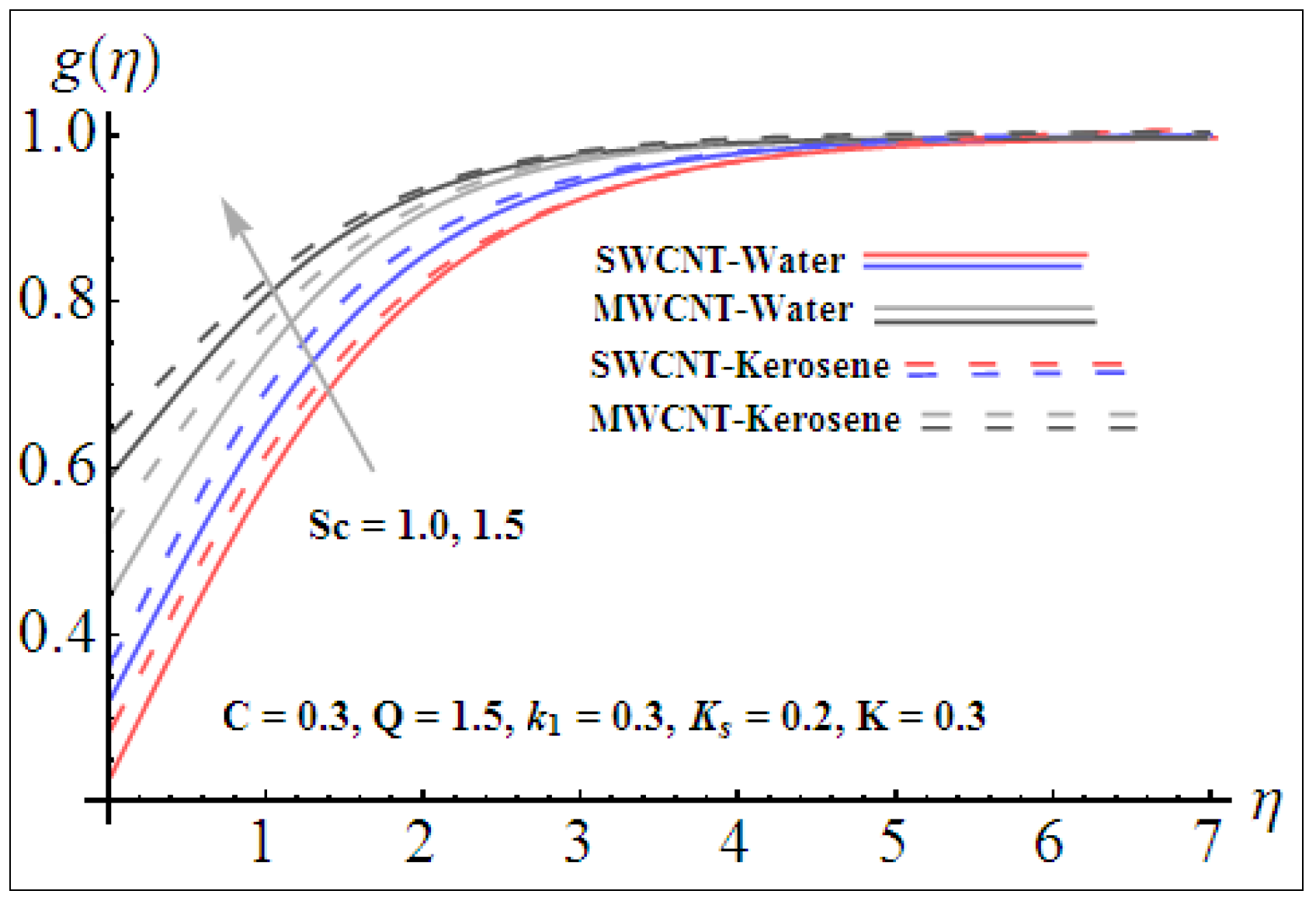
| Physical Features | Base Fluids | Nanoparticles | ||
|---|---|---|---|---|
| Water | Kerosene | SWCNT | MWCNT | |
| 997.0 | 783.0 | 2600.0 | 1600.0 | |
| 4179.0 | 2090.0 | 425.0 | 796.0 | |
| k | 0.613 | 0.145 | 6600.0 | 3000.0 |
| Water | Kerosene | ||||||
|---|---|---|---|---|---|---|---|
| Q | C | SWCNT | MWCNT | SWCNT | MWCNT | ||
| 0 | 0.3 | 0.1 | 0.3 | −1.16519 | −1.36754 | −1.16519 | −1.16519 |
| 0.1 | −1.43133 | −1.46554 | −1.47503 | −1.39579 | |||
| 0.2 | −1.76819 | −1.62734 | −1.86196 | −1.69034 | |||
| 0.2 | 0.0 | 0.1 | 0.3 | −1.56090 | −1.43595 | −1.64428 | −1.49180 |
| 0.1 | −1.63285 | −1.50239 | −1.71980 | −1.56072 | |||
| 0.2 | −1.70184 | −1.56609 | −1.79225 | −1.62680 | |||
| 0.2 | 0.3 | 0.0 | 0.3 | −1.73254 | −1.59575 | −1.82354 | −1.65695 |
| 0.1 | −1.76819 | −1.62734 | −1.86196 | −1.69034 | |||
| 0.2 | −1.80446 | −1.65938 | −1.90113 | −1.72425 | |||
| 0.2 | 0.3 | 0.1 | 0.0 | −1.73254 | −1.59575 | −1.82354 | −1.65695 |
| 0.1 | −1.74816 | −1.60966 | −1.84032 | −1.67163 | |||
| 0.2 | −1.75955 | −1.61974 | −1.85260 | −1.68228 | |||
| Water | Kerosene | ||||||||
|---|---|---|---|---|---|---|---|---|---|
| Q | C | Ec | SWCNT | MWCNT | SWCNT | MWCNT | |||
| 0.0 | 0.2 | 0.1 | 0.3 | 0.2 | 0.3 | −1.21703 | −1.21703 | −1.48849 | −1.48849 |
| 0.1 | −4.13555 | −3.98796 | −5.12215 | −5.09484 | |||||
| 0.2 | −7.94600 | −7.84866 | −9.48526 | −9.80823 | |||||
| 0.1 | 0.0 | 0.1 | 0.3 | 0.2 | 0.3 | −4.43275 | −4.26328 | −5.61607 | −5.57988 |
| 0.2 | −4.13555 | −3.98796 | −5.12215 | −5.09484 | |||||
| 0.4 | −3.88179 | −3.75257 | −4.72038 | −4.70091 | |||||
| 0.1 | 0.2 | 0.0 | 0.3 | 0.2 | 0.3 | −4.27314 | −4.10677 | −5.33273 | −5.28795 |
| 0.1 | −4.13555 | −3.98796 | −5.12215 | −5.09484 | |||||
| 0.2 | −3.99108 | −3.86425 | −4.90919 | −4.90054 | |||||
| 0.1 | 0.2 | 0.2 | 0.0 | 0.2 | 0.3 | −4.27314 | −4.10677 | −5.33273 | −5.28795 |
| 0.1 | −4.12502 | −3.97947 | −5.11316 | −5.08679 | |||||
| 0.2 | −4.03841 | −3.90523 | −4.98348 | −4.96853 | |||||
| 0.1 | 0.2 | 0.2 | 0.2 | 0.0 | 0.3 | −3.77310 | −3.63455 | −4.58980 | −4.55941 |
| 0.1 | −3.90738 | −3.77162 | −4.78703 | −4.76444 | |||||
| 0.2 | −4.03841 | −3.90523 | −4.98348 | −4.96853 | |||||
| 0.1 | 0.2 | 0.2 | 0.2 | 0.2 | 0.0 | −7.70126 | −7.20680 | −18.9855 | −17.8097 |
| 0.1 | −5.91343 | −5.62237 | −9.80372 | −9.56738 | |||||
| 0.2 | −4.03841 | −4.60906 | −6.60796 | −6.54046 | |||||
Publisher’s Note: MDPI stays neutral with regard to jurisdictional claims in published maps and institutional affiliations. |
© 2022 by the authors. Licensee MDPI, Basel, Switzerland. This article is an open access article distributed under the terms and conditions of the Creative Commons Attribution (CC BY) license (https://creativecommons.org/licenses/by/4.0/).
Share and Cite
Naseem, A.; Shafiq, A.; Naseem, F.; Farooq, M.U. Aspects of Homogeneous Heterogeneous Reactions for Nanofluid Flow Over a Riga Surface in the Presence of Viscous Dissipation. Energies 2022, 15, 6891. https://doi.org/10.3390/en15196891
Naseem A, Shafiq A, Naseem F, Farooq MU. Aspects of Homogeneous Heterogeneous Reactions for Nanofluid Flow Over a Riga Surface in the Presence of Viscous Dissipation. Energies. 2022; 15(19):6891. https://doi.org/10.3390/en15196891
Chicago/Turabian StyleNaseem, Anum, Anum Shafiq, Faiza Naseem, and Muhammad Umar Farooq. 2022. "Aspects of Homogeneous Heterogeneous Reactions for Nanofluid Flow Over a Riga Surface in the Presence of Viscous Dissipation" Energies 15, no. 19: 6891. https://doi.org/10.3390/en15196891
APA StyleNaseem, A., Shafiq, A., Naseem, F., & Farooq, M. U. (2022). Aspects of Homogeneous Heterogeneous Reactions for Nanofluid Flow Over a Riga Surface in the Presence of Viscous Dissipation. Energies, 15(19), 6891. https://doi.org/10.3390/en15196891







